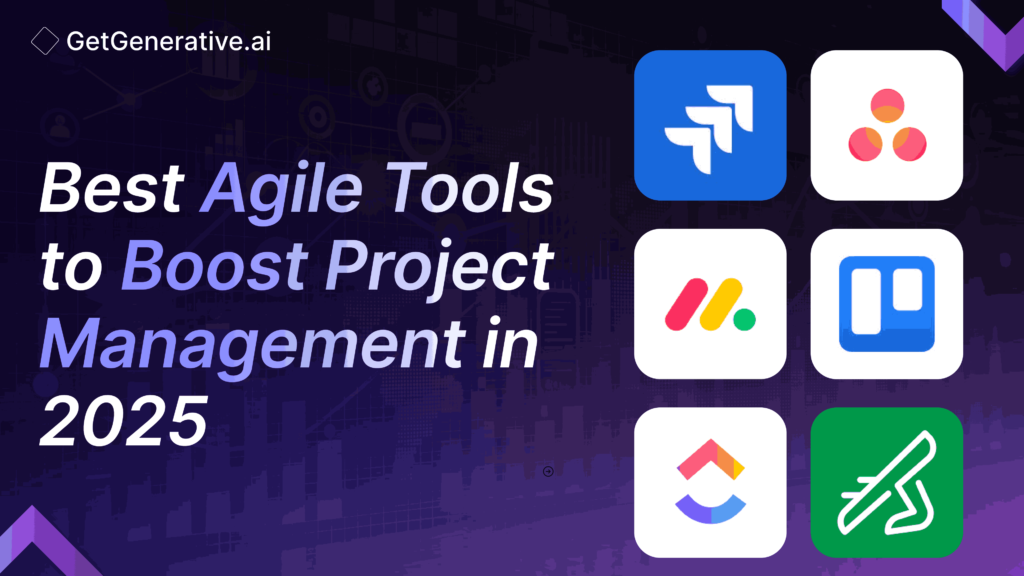Best Agile Tools to Boost Project Management in 2025
Agile methodology has become a great game changer in the fast-moving world of project management. First developed for software development, it has incorporated all other industries. This approach emphasizes collaboration, flexibility, and customer satisfaction, thus allowing quick responses to changes. However, teams might use various tools to implement Agile methodology well for communication, planning, and tracking.
This blog will discuss some of the most popular tools for implementing Agile methodologies, their features and functions, and how they improve project management.
Understanding Agile Methodology
Before diving into the tools, let’s briefly understand what Agile methodology is all about. Agile is a set of principles or ideologies that evolved out of the Agile Manifesto, focusing on:
- Individuals and Interactions over Processes and Tools: Agile is about people, not processes.
- Delivering working software without comprehensive documentation is the key objective; documentation is less important.
- Customer collaboration is better than contract negotiation. It is better to understand customer needs by involving a customer than by negotiating a contract in some legalistic manner.
- Responding to change is preferable to following a plan. Agile instills acceptance and adaptation to change as the teams react quickly to new information and changing requirements.
Agile methodology is usually deployed with various frameworks, such as Scrum, Kanban, or Lean. Each framework may have a set of unique practices and tools, but at the center of all is a desire to improve team productivity and deliver quality products.
Key Agile Methodology Tools
These are the most widely used Agile tools to support teams in effectively implementing Agile practices.
1. Jira
Jira is an Atlassian product that has gained popularity as one of the world’s most widely used project management tools. It is used to track issues and bugs and monitor project progress.
Features:
- Customizable Workflows: One prominent feature of Jira is that it allows customizable workflows, in which teams can tailor their processes and workflows.
- Scrum and Kanban boards: Jira provides two boards, work and Scrum boards, which provide the work status at a glance.
- Reporting and Analytics: Jira provides ready reports, which may include burndown charts and velocity reports, for tracking performance.
- Integration: Jira will integrate well with other tools like Confluence, Bitbucket, and Slack, which enables great collaboration.
- Benefits: Jira’s powerful features make it the best tool for teams using Scrum or Kanban. Its flexibility enables teams to customize the tool according to their needs, which ensures proper tracking and communication.
2. Trello
Trello is an unbelievably simple yet powerful tool for organizing tasks. It uses boards, lists, and cards and is fantastic for smaller teams or projects.
Features:
- Visual Task Management: Trello’s card-based system lets people create tasks with descriptions, checklists, due dates, attachments, and other features.
- Customizable Boards: Teams can create boards to account for separate projects or workflows, making it relatively easy to sort tasks.
- Automation with Butler: Trello has incorporated an automation feature, Butler, that helps automate recurring tasks.
- Advantages: Trello is user-friendly and visual, making it easier for teams to familiarize themselves with the tool. It can be used to implement Kanban-style project management and fits diverse teams of different sizes.
3. Asana
Asana is a project management tool that helps teams organize, track, and manage their work.
Features:
- Task Assignment and Tracking: Users can assign tasks to team members, set due dates, and track progress.
- Project templates: Several templates are available in asana to help set up a project and to minimize errors
- Timeline view: Users get to view their scheduled project in chronological form, hence easy planning
- Integration: Asana integrates with thousands of third-party applications, including Slack, Microsoft Teams, and Google Drive.
- Benefits: It has numerous benefits for teams trying to work better collaboratively or needing high project visibility.
Also Read – Top Business Tools for Consultants in 2024
4. Monday.com
Monday.com is a customizable work operating system that lets a team create its workflow and process.
Features:
- Custom Workflows: This platform allows teams to create customized workflows tailored to their needs, along with Kanban, Gantt, and timeline views
- Automation capabilities: The automation capabilities of this software facilitate the streamlining of mundane, repetitive tasks.
- Dashboards: Users can create personal and customized dashboards representing the project progress and key metrics.
- Collaboration Tools: Communication tools are built in, enabling teams to work effectively through Monday.com.
- Benefits: It is suitable for any team and project due to its flexibility and customization. Users can adapt it according to their needs.
5. ClickUp
ClickUp is a one-all project management tool that has managed to harmonize tasks, docs, goals, and chats into one platform.
Features:
- Task Management: ClickUp has multiple views that can be applied as lists, boards, and even Gantt for tasks.
- Goal Setting and Tracking: Teams can set and track goals in the platform.
- Integrations: ClickUp integrates with multiple tools, including Slack, GitHub, Google Drive, etc.
- Custom Fields: Users can create one or more custom fields to capture specific data related to the tasks.
- Benefits: ClickUp is a great option for teams looking to consolidate project management tools because its feature set is comprehensive and flexible.
6. Microsoft Azure DevOps
This is a DevOps service provided by Microsoft for software teams. It encompasses project management, CI/CD pipelines, and testing tools.
Features:
- Boards: It is supported through Kanban boards for managing tasks and tracking work progress.
- Version Control: The tool integrates with Git for version control, enabling seamless collaboration on the source code.
- Build and Release Management: The tool automates the build and deployment process, thus saving time and increasing the delivery speed.
- Reporting: It offers highly evolved reporting capabilities of how the team and projects perform.
- Benefits: Azure DevOps’s core benefit is an integrated solution that brings several tools for managing projects and development. This is great news for software development teams.
7. Slack
Slack is not a project management tool per se but rather a communication platform used by Agile teams.
Features:
- Channels: Users can create channels for specific projects or topics, thus creating a focused discussion.
- Integrations: Slack integrates many project management tools, allowing teams to receive updates and notifications on the platform.
- File Sharing: Teams can easily share documents, images, and other files, thus easing communication.
- Benefits: Slack increases the efficiency of team communication, ensuring everyone stays informed and connected. It is indispensable for successful Agile implementation.
What’s the best choice?
Consider the following when making your selection of Agile methodology tools:
- Team Size and Structure: Large teams require powerful tools with significant features, but smaller teams require less complicated solutions.
- Complexity level: More complex projects require too much elaborate tracking and reporting.
- Integration: Ensure that your chosen tools can integrate well into other software or tools your team uses.
- User Experience: The more user-friendly the tool, the more likely people will adopt it. When a tool is intuitive and easy to use, people will be inspired to collaborate and become effective.
Conclusion
Agile methodology transforms how teams work on projects; they are more collaborative and adaptive. Communication, planning, and tracking go much smoother with the right tools. Whether Jira and Trello, ClickUp, or Azure DevOps, each tool does something uniquely different to support individual team needs.
Visit GetGenerative.ai to learn more!




